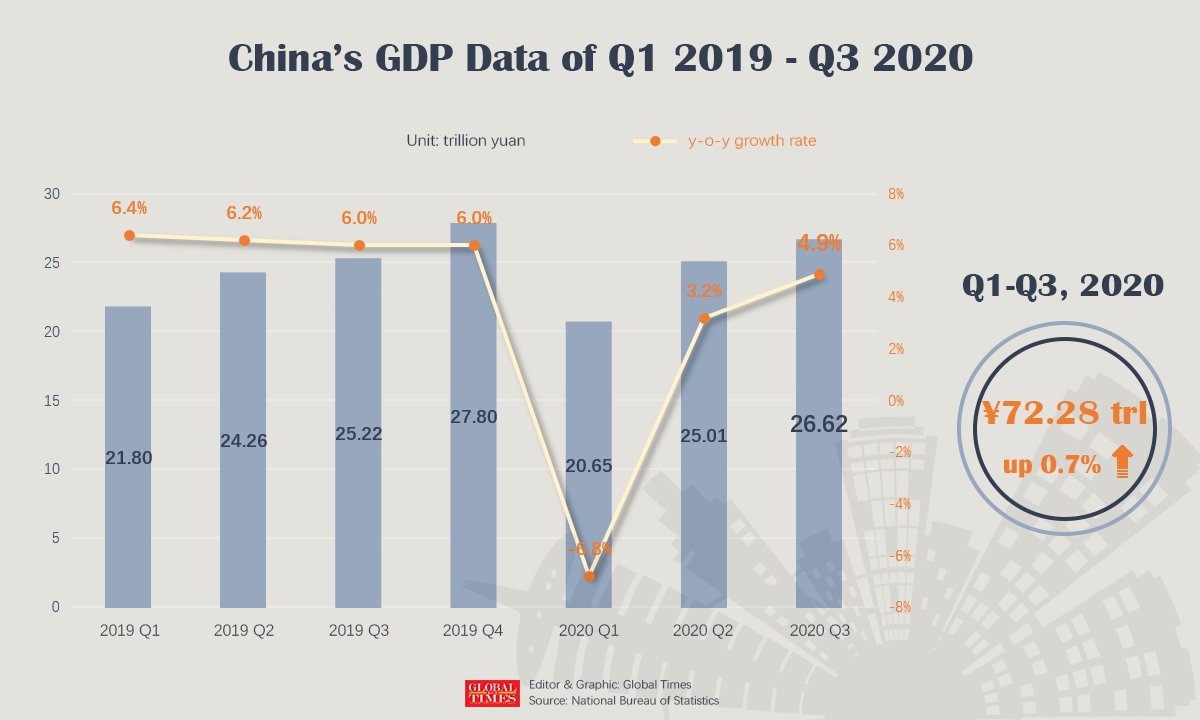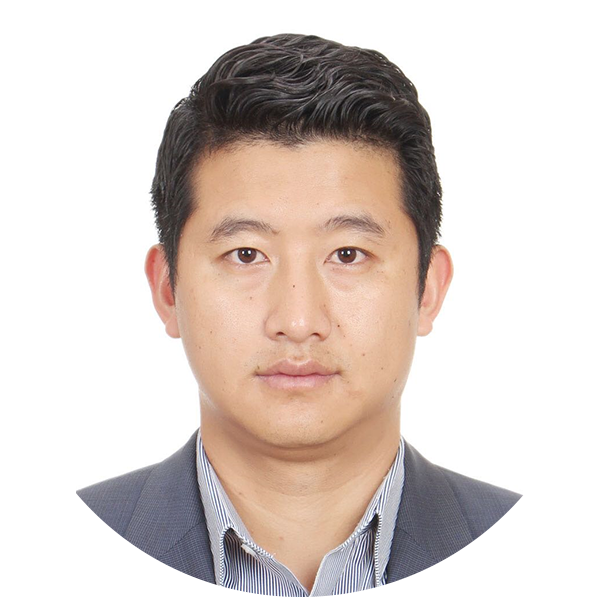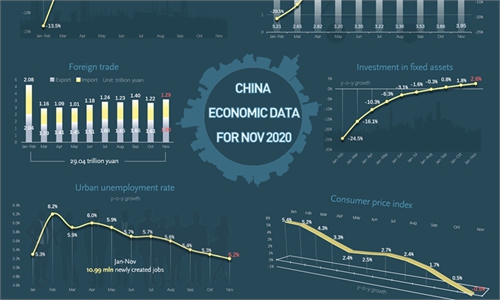Top meeting in Beijing to focus on tackling major risks in 2021, as robust growth expected

China’s GDP Data of Q1 2019 - Q3 2020 Infographic: GT
Chinese top policymakers are expected to outline economic policy priorities and targets for 2021 at a highly-anticipated tone-setting meeting, which could pave the way for the most significant shift in China's economic development model in decades that puts more focus on boosting the domestic market and indigenous innovation to drive long-term growth, as external uncertainties and risks remain abundant.
The annual Central Economic Work Conference is usually a window for domestic and global markets to find clues in Chinese top leadership's reading of the world's second-largest economy and policy directions for the coming year. But this year's meeting has elevated significance, as 2021 will mark a critical inflection point for the Chinese economy, when China seeks to further consolidate its steady recovery from the COVID-19 pandemic, start the 14th Five-Year Plan (2021-25) and embark on its next centennial goal of building a modern socialist power.
Meeting for clues
The conference, which is attended by China's top leadership and senior officials from across the country, usually takes place in mid-December. Traditionally, no official information about the closed-door meeting would be released other than a final statement released at its conclusion. In line with that tradition, it remains unclear when the meeting will take place this year.
However, several signs indicate the conference might have already started.
One of the indications is the arrival in Beijing of Party chiefs from many provinces. According to the Beijing Youth Daily, at least 11 provincial Party chiefs or governors have already arrived in Beijing to attend various activities, including the Party chief of Northeast China's Jilin Province Jing Junhai and the Governor of Northwest China's Qinghai Province Xin Changxing.
Another indication was the Political Bureau of the Communist Party of China Central Committee on December 11 convened a meeting to analyze the economic work for 2021, which usually comes just days before the Central Economic Work Conference.
While details of the meeting remain scarce, there are many signs and clues to watch out for this year as to how China's top policymakers plan to ensure stable growth not just in 2021, while tackling a flurry of internal and external challenges, according to analysts.
Among the most closely-watched outcome of the conference is the growth target for the Chinese economy in 2021. Previously, top officials would set a growth target at the meeting and publish it months later at the Two Sessions, but China has scrapped a specific numerical target to better coordinate policies to cope with new challenges, analysts noted.
"I don't think there will be any mention of a specific growth target this year, rather it will stick to description of stabilizing six areas," Li Chang'an, a professor at the University of International Business and Economics' School of Public Administration, told the Global Times, referring to officials' stated goals of stabilizing the jobs market, financial market, trade, foreign capital, investment and expectations.
Still, analysts said that major efforts could be put in place to ensure relatively high-speed growth in 2021 to start the first year of the 14th Five-Year Plan on a strong footing. Coming on the heels of what officials call a "strategic victory" over the virus and steady recovery, the Chinese economy is expected to grow at around 2 percent in 2020 and about 8 percent in 2021, taking the global lead, according to various projections.
That would also offer Chinese policymakers sufficient room to make major policy shifts to address risks for the domestic economy, analysts noted.
Among the most pressing issue to be addressed in 2021 could be mounting government and corporate debt, according to Tian Yun, vice director of the Beijing Economic Operation Association. "The leverage ratio has increased so fast that it poses a huge risk," Tian told the Global Times, noting that leverage ratio has reached the level in the aftermath of the global financial crisis in 2009. "So deleveraging will be a priority for next year's economic work."
Chinese policymakers are also expected to tighten anti-monopoly regulations and stop the "disorderly" expansion of capital, analysts added, pointing to similar language coming out of the Political Bureau meeting last week.
Long-term issues
Given that 2021 would be the first year of the 14th Five-Year Plan and the start of China's pursuit of its next centennial goal, there could also be policy initiatives and sweeping reforms outlined at this year's Central Economic Work Conference to ensure long-term economic growth and security, analysts noted.
"The most important theme could be the Chinese government's focus on reforms on the demand side in the next five years" to boost domestic demand, Wei Jianguo, former Chinese vice minister of commerce and executive deputy director of the China Center for International Economic Exchanges, told the Global Times.
Demand side reform has already become a buzz phrase after the Political Bureau meeting on December 11 first mentioned that China should carry out reforms on both supply and demand sides to achieve a dynamic equilibrium at a higher level, in which demand and supply can boost each other.
While the meeting did not offer further details as to what that entails, analysts said that demand side reform is part of the country's new dual circulation development paradigm, under which the domestic market has become a crucial aspect of ensuring economic growth, as external risks continues to grow with the COVID-19 along with trade tensions with the US.
Specifically, demand side reform will include efforts to boost wages through job creation and income distribution, expand the social safety net and improve consumer services at companies as well as government agencies, according to Wei, adding that the slow recovery in consumption from the pandemic added urgency to these reform efforts.
The Political Bureau meeting concluded that the Chinese economy has gradually rebounded to "normal performances," but uncertainties related to the COVID-19 and the external environment continue to loom large, according to the Xinhua News Agency. The meeting also urged efforts to form a new development paradigm that focuses on advancing high-quality development.
"The dual circulation development paradigm will remain a main theme of economic policy in China for many years to come," Tian said, adding that decisive reforms will be required to address structural issues in the domestic economy, including a growing income gap and unemployment of university students.
Also as part of China's long-term economic goals, Chinese policymakers are likely to roll out a slew of initiatives to bolster domestic technological innovation capabilities, as top officials have repeatedly called for building more independent and controllable industrial supply chains, analysts said, adding that the technology rivalry with the US could further escalate, which threatens China's economic security.
"As the pandemic revealed, China's reliance on the world is decreasing, while the world's reliance on China is increasing. So we have to further build on that and significantly boost our domestic economy to cope with any potential risks," Wei said.




